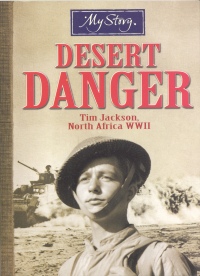| ________________
CM . . .
. Volume XIV Number 21. . . .June 13, 2008
excerpt:
Desert Danger, the latest instalment in Scholastic's excellent "My Story" series on the First and Second World Wars, is the tale of Tim Jackson, a Royal Engineer, who were known as "sappers." Tim was posted with General Bernard Montgomery's 8th British Army during the 1942 North African campaign. Tim's story is both exciting and moving and is a welcome addition to the series. Readers first meet Tim in war-ravaged London which was suffering from daily German Luftwaffe bombing. Barely past his eighteenth birthday, Tim was drafted into the British army and assigned to the Royal Engineers. He began his training in the dangerous work of laying landmines, which were used to slow down the German's advance, and also in defusing the enemy's landmines. After only a few short weeks of intensive training, Tim and his fellow recruits were shipped off to North Africa to join the British 8th Army which was trapped in the desert just outside Alexandria, Egypt. Soon Tim and his "mates" found themselves under intense fire as German Field-Marshall Erwin Rommel's forces tried to break the British Army's line at the Battle of Alam Halfa, but the famed "Desert Rats" held firm. After recuperating from the German assault, the British forces counterattacked at El Alemein and proceeded to slowly push the German lines back to Libya and achieve ultimate victory.
Recommended. Ian Stewart teaches at David Livingstone School in Winnipeg, MB.
To comment
on this title or this review, send mail to cm@umanitoba.ca.
Copyright © the Manitoba Library Association. Reproduction for personal
use is permitted only if this copyright notice is maintained. Any
other reproduction is prohibited without permission.
NEXT REVIEW |
TABLE OF CONTENTS FOR THIS ISSUE
- June 13, 2008.
AUTHORS |
TITLES |
MEDIA REVIEWS |
PROFILES |
BACK ISSUES |
SEARCH |
CMARCHIVE |
HOME |
